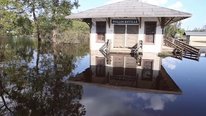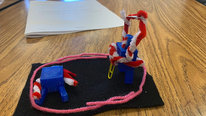- Robert Reardon
- Associate Professor
- Presenter’s NSFRESOURCECENTERS
- East Carolina University
- Robert Quinn
- https://www.linkedin.com/in/rdquinn/
- Associate Professor of Art Education
- Presenter’s NSFRESOURCECENTERS
- East Carolina University
- Ronnie Smith
- Associate Professor
- Presenter’s NSFRESOURCECENTERS
- East Carolina University
Integrating the Computer Science and Computational Thinking in Three Rural Ea...
NSF Awards: 1738767
2022 (see original presentation & discussion)
Grades 6-8
The teachers participating in final year of the Integrating Computational Thinking in Music and Visual Arts project confronted a multitude of challenges stemming from the ravages of COVID-19. We draw on the highlights of project to celebrate the achievements of the middle school students who participated over the five years of the project.
Instructional Materials
East Carolina Univ
Innovative Technology Experiences for Students and Teachers (ITEST)
Related Content for Music, Artistry, and Computational Thinking
-
 2019We are the A in STEAM
2019We are the A in STEAM
Robert Reardon
-
 2021Embodied Coding in Augmented and Virtual Reality
2021Embodied Coding in Augmented and Virtual Reality
Ying Wu
-
 2020Interpreting Hurricane Florence
2020Interpreting Hurricane Florence
Robert Reardon
-
 2022An Immersive Programming Environment for Learning to Code
2022An Immersive Programming Environment for Learning to Code
Ying Wu
-
 2022Exploring Virtual Reality with Secondary STEM Teachers
2022Exploring Virtual Reality with Secondary STEM Teachers
Nastassia Jones
-
 2022Co-designing Inclusive and Place-Based STEM Programs
2022Co-designing Inclusive and Place-Based STEM Programs
Evrim Baran
-
 2022Augmented Reality in Biology Class
2022Augmented Reality in Biology Class
Elizabeth Radday
-
 2022Math and Computational Thinking Through 3D Making
2022Math and Computational Thinking Through 3D Making
jennifer Knudsen
This video has had approximately 257 visits by 219 visitors from 63 unique locations. It has been played 49 times as of 05/2023.
Map reflects activity with this presentation from the 2022 STEM For All Video Showcase website, as well as the STEM For All Multiplex website. 
Based on periodically updated Google Analytics data. This is intended to show usage trends but may not capture all activity from every visitor.
show more
Discussion from the 2022 STEM For All Video Showcase (14 posts)



Ekundayo Shittu
Impressive project! This is at the nexus of science and arts. These are the projects that blur the distinguishing lines between arts and science. This is excellent! I voted!!
Robert Reardon
Associate Professor
Many thanks, Ekundayo. It was an amazing educational journey for all of us.
David Haury
Emeritus Professor
Situating computational thinking in the context of music and the visual arts is a very innovative idea. One person in the video expressed the idea that “language is the barrier.” Could you say more about what aspects of your approach most likely reduced that barrier
Ronnie Smith
Associate Professor
Thanks David for your question. With respect to the teachers and students, it was the initial grounding of the computational ideas in traditional artistic and musical activities followed by extensions of these ideas into activities that involved novel technologies (relative to the students' background). Our teachers were fantastic at developing lessons to reinforce for students their exposure to the computational concepts.
For parents, we had a "Community Learning Exchange" event, a 1/2 day Saturday gathering at a central location (tricky when your students are scattered in several rural areas) where students from the various schools shared their work and we also presented a brief introduction to the idea of computational thinking from a computer science perspective. This occurred about 1 year into the project in January 2019. Regrettably, the pandemic thwarted any attempt we might have made for a followup gathering in future years (other than the Big Reveal in November 2019).
Jessica Parker
Senior Director
Thanks for sharing your video that celebrates some of the achievements of middle school students engaged in the project. I would love to learn more about some of the specific projects that students presented at "The Big Reveal" as they used weather data to integrate computational thinking in music and visual arts. What did students create, how did they share it at The Big Reveal, and what were potential impacts of this project on students?
Robert Reardon
Associate Professor
Thanks for asking, Jessica.
In a nutshell: The Big Reveal was the culmination of an artist-in-residency by a highly accomplished artist (Nathalie Miebach; https://nathaliemiebach.com/). Nathalie constructed quite large woven canoes (~ 5 feet long) with the assistance of one of ECU students in the Jenkins Fine Arts Center. She then went with my colleagues and I to deliver a canoe to each of the visual arts schools and encourage the students to "load" the canoes with artistic products that emanated from their recent experience of a major hurricane and historic flooding in the region. Nathalie showed the students at the music school how to construct a graphic score to record their experience. The students were charged as part of the loading of their canoe/graphic score construction to research and incorporate meteorological data on the progression of the hurricane and the subsequent flooding. This was an engrossing project that incorporated the concepts and approaches that constituted our definition of computational thinking in addition to prompting the students to collectively process their experiences.
After Nathalie introduced the students to the concept, they worked on this project for two weeks and then the students from all three schools and many parents and ECU faculty gathered at ECU to listen to the students discuss and display their projects and (in the case of the school that was focused on music) to listen to their graphic scores being interpreted by ECU music and dance students. The canoes and graphical scores went on display in one of the art galleries at ECU before being returned to the schools.
Undoubtedly one of the high points of the grant!
Jessica Parker
Denice Blair
Great project! I love how you included the voices of students in the video. Also, you incorporated a lot of different technology into their work, including Merge Cube. I've been curious about using Merge Cube. Can you say a bit about what the learning curve was like for students?
Ronnie Smith
Associate Professor
Thanks Denice for your question. Important context---in terms of project timeline, we first began engaging our teachers and students with CoSpaces in February 2020 (oops). So we got no chance to go to the schools directly to provide instruction---everything had to be done remotely. Within that situation, the learning curve was quite challenging as students were meeting face-to-face with their teacher on an irregular basis. Very few students had reliable high-speed internet access at home. Fortunately, we had an outstanding graduate assistant who provided some very nice tutorials and sample assignments for the students and teacher to pursue.
Not being able to provide face-to-face instruction made student learning for the Merge Cube especially challenging. In general with the project, once students had a light bulb come on about the new possibilities for artistic expression that a new technology offered, they tended to respond very well. Given more time and direct instruction, I think it would have happened with the Merge Cube as well. There were a couple of students who were able to produce some interesting work with the Merge Cube, but time really just ran out as it was near the end of their school term when it happened.
Though we have limited experience to draw on, my professional intuition as a computer scientist leads me to believe that if you can have direct face-to-face instruction three times a week with the students, they should learn a great deal over time.
Robert Reardon
Associate Professor
Denice: Further to Ronnie's response, one of my favorite memories of the whole project was the Teams meeting in which Amber (the outstanding GA) and I were meeting virtually with one of the art classes. The teacher had us projected on to a large screen and we could see them via the teacher's laptop. They had been dabbling with CoSpaces and had shared their responses to a task that Amber had set for them. Then we shared our screen and Amber activated the Merge cube and showed the 3D rotation that I included in the video. I know it is platitudinous to say the their eyes stood out on stalks, but they did! The art teacher later told me she had to order them to go to lunch at the end of that class. Imagine Grade 8 students being ordered to go to lunch!
The next week, schools across the state went to virtual attendance--as Ronnie noted.
Victor Minces
I love the concepts. We are developing a programming language for making music that leverages the similarities between CS and music. I'd love to hear your advice and perhaps collaborate for spreading our program. My contact is vminces@ucsd.edu
Thanks!
Robert Reardon
Associate Professor
Sounds great, Victor. Our music teacher is a fan of Scratch and I generated an activity that involved exploring ABC notation and using EasyABC (a problem in the Apple environment). Ronnie is our resident CS expert so we can talk more down the track. reardonr@ecu.edu
Nancy Songer
Dean
Thank you for sharing your project. This is a very exciting integration of science, arts, and engineering. Can you say more about how you are measuring the impact of the project?
Robert Reardon
Associate Professor
Great question, Nancy. The teachers' intuitions were very important to us, the students were highly engaged in the activities (time-on-task; see my editorial on Ronnie's response above), and I included a clip in the video of one parent's perspective of the worth of the project.
As for formal assessment of students' learning, this was a challenge that we wrestled with from the outset. What we soon found out was that the existing assessment instruments were oriented to either a particular computer programming language (coding) or environment or a particular implementation. I argued against assessing students' products for "alignment to" or "conformity with" with an exemplar since (a) our definition of computational thinking focused on concepts and approaches (see Barefoot: https://www.barefootcomputing.org/resources/com...) and (b) it seemed quite discordant with the nature of an inherently creative endeavor.
Our approach was to invite students to share their concepts through participation in focus groups and their approaches through indicating the extent to which they employed each of the five approaches described in the definition of computational thinking (tinkering, creating, debugging, persevering, and collaboration) by placing a check on labelled continua.
Robert Reardon
Associate Professor
And I should have mentioned the clip in the video of one of the focus groups in which a student declared that he couldn't wait for art class!
Further posting is closed as the event has ended.